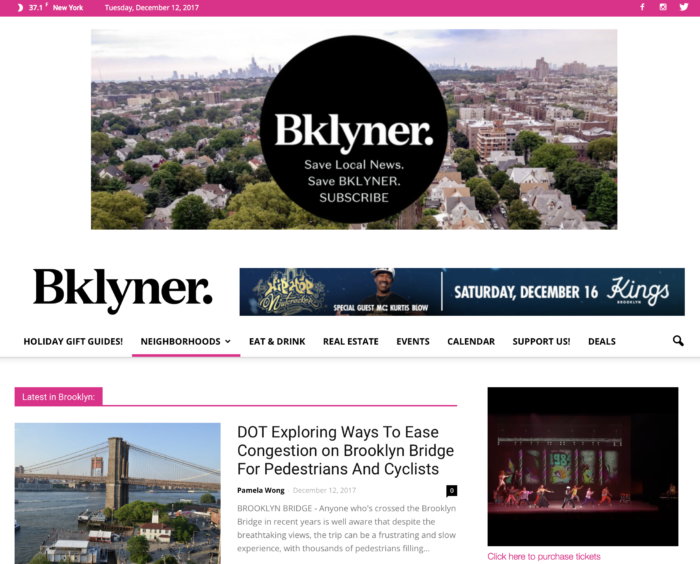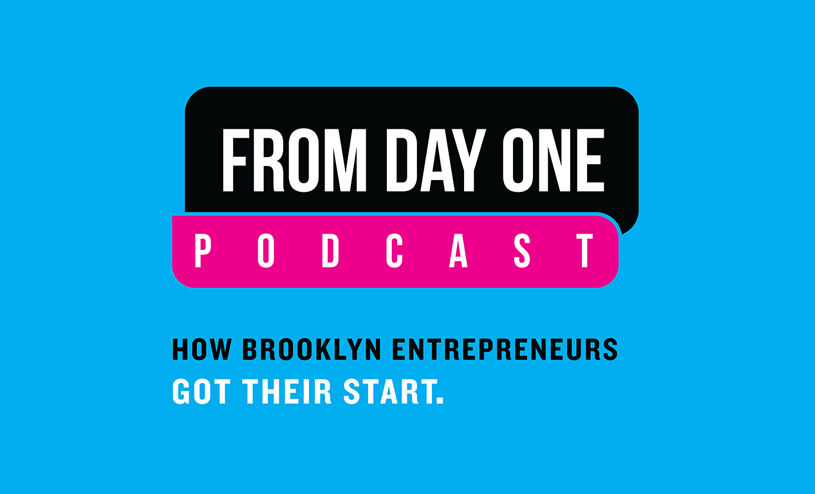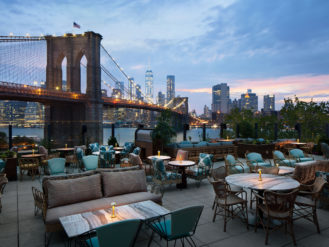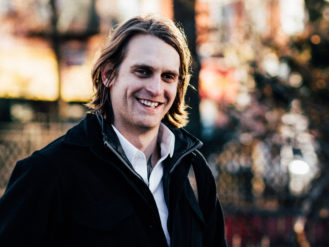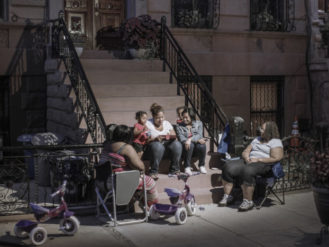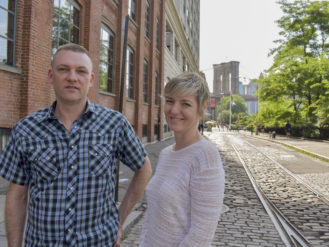Brooklyn BBQ Got Burned. Here’s What It’s Really Like
It was hard to ignore all the burns the Internet made this week regarding “Brooklyn BBQ” after a republished 2014 article on the Vice Media site Munchies went viral. The story featured a bombastic headline (‘Why Is Brooklyn Barbecue Taking Over the World?’) and a photo from Williamsburg BBQ joint Fette Sau showing the saddest, sparsest BBQ platter ever.
Articles from Texas, North Carolina, Kansas City, and just about anywhere that has a BBQ scene derided the entirety of Brooklyn BBQ based almost exclusively on a single photo and headline. A few of the memes based on the photo were genuinely funny, but the jeers were deafening and even national politicians weighed in.
There were two primary reasons the story and the photo took off like it did: regional BBQ pride and a lack of knowledge of what makes Brooklyn BBQ special.
When it comes to pride, BBQ fans get passionate about the style and region their barbecue comes from because either they grew up with it or have spent a lot of time around it. For example, I grew up in Kansas City and have spent ten years in New York, so I’m inclined to show a little passion for KC and NYC BBQ. Some of my best memories involve eating amazing BBQ with friends and family. So when someone claims another region’s BBQ is better than yours in some way, it’s easy to go on the defensive. Think of rooting for local BBQ like you root for a local sports team and it starts to make sense.
But even bigger than regional BBQ pride, what really got the BBQ commentariat in a tizzy is that most of the people writing stories and making nasty comments actually know little or nothing about the Brooklyn BBQ scene. They saw one bad photo and, without any research, they dismissed one of the most exciting and inventive places to eat barbecue in the U.S.

The much-maligned photo that was recirculated by the Munchies social media team this week made Fette Sau look lame, when it’s not (Photo via Munchies/Twitter)
Let’s start with Fette Sau, which got the rawest deal in all of this because the terrible photo was from their establishment. The image features a mostly barren platter with four slices of brisket, two scrunched potato rolls, two bleh pickles, and a craft beer. In the BBQ world, platters are typically filled to the brim of several types of meats and sides, so this photo drove people mad.
But Fette Sau has been around since 2007 and is one of the best-liked staples in Brooklyn BBQ. Owner Joe Carroll brought many of the oldest traditions in barbecue under one roof (check out his excellent book if you want to know more) and the part-country, part-hipster aesthetic has been copied in New York and around the world. Four North Carolina reporters even visited Fette Sau this week and loved their experience. “Not one minute after we walked into the garage-turned-barbecue joint, we realized just how wrong the world had gotten it about Fette Sau and the meats our neighbors to the north are pulling out of the smoker daily,” one of them wrote.

The Jamaican Jerk baby back ribs from Hometown Bar-B-Que show off Brooklyn BBQ’s willingness to combine tradition and experimentation (Photo by Sean Ludwig/NYCBBQ)
If naysayers aren’t convinced and want to see the pinnacle of what Brooklyn BBQ can be, look no further than Hometown Bar-B-Que in Red Hook. Since it opened in September 2013 by pitmaster Billy Durney, it has attracted high praise from tough food critics and it even has fans from Texas. Just about anything you order on the menu is highly satisfying, whether its brisket, beef ribs, pork ribs, pulled pork–you name it. Hometown also embraces bold new menu items you normally won’t see on a BBQ menu, like Jamaican Jerk baby back ribs, Korean sticky ribs, and Vietnamese hot wings.
While Hometown has in many ways become the de facto example of how good Brooklyn BBQ can be, there are many other honest-to-goodness real barbecue joints in Brooklyn that are sincerely worth your time, including Izzy’s Brooklyn Smokehouse, Pig Beach, Arrogant Swine, Fletcher’s Brooklyn Barbecue, Morgan’s Barbecue, and Mable’s Smokehouse. All of these BBQ joints make up a marvelous tapestry of BBQ, with nearly every regional style of barbecue from around the U.S. represented.

Pig Beach in Gowanus has great food but also features one of the most inviting outdoor spaces in Brooklyn (Photo by Sean Ludwig/NYCBBQ)
Similar to Hometown’s philosophy, what sets Brooklyn apart is its embrace of American BBQ traditions while also experimenting with new ideas. Izzy’s Brooklyn Smokehouse in Crown Heights is a kosher barbecue joint that impresses discerning non-kosher meat eaters with its beef ribs and brisket while also featuring specials like lamb and pastrami that sell out fast.
Arrogant Swine in Bushwick makes you feel like you’re in the Carolinas with its chopped whole hog and mustard-slathered ribs, while also offering smoked chicken wings covered in Vietnamese caramel sauce. Pig Beach in Gowanus takes BBQ cues from around the U.S. but also offers standout burgers and tri-tip steak.
Brooklyn BBQ joints also excel with creative spaces. Pig Beach, Arrogant Swine, and Hometown all have large seating areas—some indoor and some outdoor—that can comfortably fit huge crowds and make BBQ into a family or friends event. Almost every joint in Brooklyn also has a well-stocked bar full of craft beer and fun cocktails, meaning you could spend a whole day of drinking and eating in the same spot.
To be fair, the author of the Munchies piece says he never intended to slight Brooklyn, or provoke such a backlash. “[Nicholas] Gill found it intriguing that a barbecue joint in Brooklyn had become influential in faraway places, and he reported on it. He wasn’t aiming for controversy, or even offering an opinion,” wrote Texas Monthly this week. “Gill felt some guilt. ‘They’re getting dragged into it because of my silly photo,’ he said. He shot the paltry serving of brisket on a mostly empty tray almost as an afterthought on his iPhone.”
Still, it’s too bad the Munchies episode went and made a joke out of Brooklyn BBQ. The real joke is on any serious barbecue fan who never makes it to Brooklyn to see how great our BBQ is.

The author enjoying a proper plate of Brooklyn BBQ
What Made That Café Fail? Lessons from a Tough Business
Carroll Gardens has lost a gem.
Sheila’s, the all-day bakery, café and restaurant, which opened in May and The Bridge profiled a few short months ago, served its last meal on Dec. 10. Of course, a restaurant closing isn’t a shock these days, given the ultra competitive and cyclical nature of New York’s culinary world. Restaurants come and go in this borough like passing fads, as a stroll down Smith Street will prove.
But Sheila’s surprise closing is more distressing than most. Maybe it was because of how deeply the team wanted to integrate into the neighborhood. Maybe it’s because of the loss of that charming outdoor space. Maybe it’s because the owners, Colin Clarke and his wife Molly Carlot-Clarke—were so kind and hard-working. In a year like we’ve just had, you want to believe that kind and hard-working people who pour their best efforts into a project will achieve success, because that’s how the world should work.
We tend to want to place blame or figure out the cause, but the sad fact, according to owner Clarke, is things in the restaurant world are rarely so black-and-white as “wrong time” or “wrong place.” In this case, staying open would have required, at a minimum, raising menu prices significantly, and the huge endeavor of shifting the pricing structure still wouldn’t guarantee success. Alternatively, Clarke says, they would have needed visits to the restaurant to double or triple, which wouldn’t happen overnight. Because of their spot on south Court Street, they needed to access diners from surrounding neighborhoods, which takes publicity, marketing, and the big one: time.

Clarke and his wife Molly Carlot-Clarke at their favorite table in the restaurant (Photo by Harry Koepp)
Reflecting on what he learned through the process, Clarke says there was a high density of small lessons, from cosmetic changes to ingredients to presentation. His advice for aspiring restauranteurs? “What you need to have is a high level of grit and resolve. There were so many times when things will happen and you’re like, ‘That’s it, we’re done, and we can’t overcome them.’ Even when it came to [the end], with our finances, we thought, we’ve overcome so many challenges already, how can we overcome this one?” he says. “You may think you’re scrappy and gritty and you can roll up your sleeves, but times that by ten.”
He also points to the warm reception from a base of neighborhood regulars–some shed tears when they heard the news–as crucial in those early days: “The amount of support that we got from Carroll Gardens was amazing and deep and nurturing. It wasn’t our experience that people weren’t supporting us. But was it enough people? That’s a different thing.”
For neighbors of the closed restaurant, there’s a pang of guilt, which will be more acute if the closed restaurant is replaced by yet another real-estate brokerage. What else could have been done? How often do you see a place shuttered and think, “Wow, and I never got around to trying that brisket hash”? But it takes a lot of effort to integrate a new place into your routine. And if you live even a mile away, the restaurant might as well be in Iceland. It’s easy to wear your neighborhood goggles, and cling to standbys that make the city feel accessible, doable. But it’s also restrictive—you can’t like what you don’t try.
Understanding the complexity of what makes a success can also help you discover how to support your favorite businesses. Here are some easy ways to become super fans of new businesses throughout the new year:
Look Beyond Your Block
Seeking out new places in your neighborhood is the easiest path, but why not go one neighborhood over? When figuring out a dinner place, Clark says he would ask himself, Which neighborhood do I want to spend time in? If you’re having a good time, chat up the servers or owners. Starting a business is full of challenges—the rules and regulations alone will make your eyes bleed—and owners are worried about positive public reception; developing a connection with them can make you more invested in their success.
And maybe one solution is this: Instead of ignoring this disconnect between owner and customer, try to remember that where you choose to spend your money, your time, your presence, doesn’t go into a silo. Rather, it contributes to Brooklyn’s ever-changing and actually quite finicky ecosystem. And if we want that ecosystem to flourish, well, you know the rest: you have to put your money where your mouth is.
Once You Go, Go Again
Repeat customers are crucial for small businesses, especially mom-and-pop ones that rely on regulars to stop by a few times a week, or even daily. One benefit? Becoming a regular can make you feel like a million bucks (which actually doesn’t stretch very far in Brooklyn anymore, but you know what I mean). Feeling comfortable and known in an establishment can create a sense of community in your neighborhood.
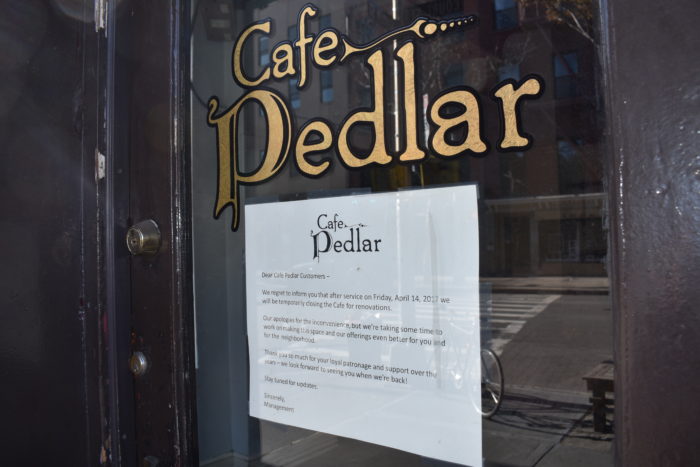
A few blocks north of Sheila’s on Court Street, a sign tells customers that Cafe Pedlar has closed for renovations, but it hasn’t reopened (Photo by Steve Koepp)
Post About Your Visit
Snap a pic of that delicious pastry or perfect latte art and give a new coffee shop some free press. Rather than thinking of restaurants as providing a service–which they are, of course–consider the people involved, from the owners to the host, and how letting others know about your experience will help those people keep their jobs.
Tell Your Friends—and Strangers!
Everyone has a tuned-in friend who knows what’s opening, closing, or too hot to snag a seat. You, too, can develop this enviable social cachet by texting your friends after a stellar restaurant visit and telling them to give it a try. Word of mouth is the most powerful form of marketing. If I see someone standing on the sidewalk peering at the menu in the window of one of my favorite restaurants, I like to stop and say, “It’s great! You should get the burger!” (Apparently, my life’s passion is pushing good burgers on trusting strangers.)
A tiny comment could push someone to stop in, enjoy themselves, maybe become a regular. And then you’ll both avoid the sad fate of walking past storefronts papered with hand-scrawled signs with the depressing proclamation: “Thanks for the memories!”
Make It a Game
Speaking of burgers, one of the best food summers of my life was when my friend Jane and I decided to go on a “burger crawl.” We didn’t stuff ourselves with sirloin in a single day; but when it came time to catch up, we always sought out places with a stellar burger option, which not only made it easier to decide on lunch plans, but also drew us away from our typical haunts. Find an adventurous friend and tick off all those cuisines you’ve never tried.
And next time you feel like stopping by the convenient option, take a look around—what haven’t you tried? What can you try? What will you try? Your new favorite spot might be just around the corner.
Inside a Brooklyn News Site’s Last-ditch Campaign
If you like your cheese, your bourbon, and your chocolate locally sourced—chances are you like your news local, too.
Another New York City local-news organization is in trouble, and they’re asking for reader support. Just last month, Gothamist and DNAinfo were shut down—and temporarily taken offline as well, though now the archives are back up and can be accessed. That death knell came after Gothamist’s spring sale to billionaire Joe Ricketts, founder of DNAinfo, and the decision by the digital newsrooms to unionize. The fight did not end well, and after 14 years and tens of thousands of articles, the formerly Dumbo-based Gothamist is dead.
Now BKLYNER, a reporting-driven local news site for all things Brooklyn, is also on the verge of a shutdown. On Dec. 6, editor and publisher Liena Zagare announced on BKLYNER’s newsletter list and on the site, “We cannot make ends meet under our current advertising-based business model. Like hundreds of other news outlets around the country, we’ve found it impossible to sustain a robust news organization on local ad sales alone.”
There wasn’t much warning—if they don’t reach their goal of 3,000 subscribers (only 1% of their total readership, Zagare says), the site will close by Dec. 31. The news likely comes as a surprise to readers, though it shouldn’t. It’s easy to take for granted something that’s free and not consider how the sausage is made. “In 2017, local independent media sources like ours are in real trouble,” Zagare wrote. “Revenue from advertising and classifieds that once fueled local news is now being lost to Facebook, Google, and other global internet giants. We cut our costs deeply last year, but it wasn’t enough.” Update on Jan. 3: by year’s end, BKLYNER drew 1,745 paying subscribers and decided to stay in business.
We got in touch with Zagare for more details about her decision—and she’s blunt and realistic: “Without reader support I think there is absolutely no future for local journalism.”
Q: You’ve been running local news sites for awhile now. How has the business changed?
Zagare: It has changed immensely! I started ditmasparkblog on Blogger as a hobby. It grew and I have been trying to figure out how to make neighborhood news profitable (or to at least break even) ever since. For a while, working with small businesses worked—once you had critical mass of readership, they knew where to find you. But it was never quite sufficient to offer a reporter a steady job. We started working with larger institutions and the city. We consolidated the business end of a number of sites. We could still not make ends meet. So then, this time last year, we tried asking neighbors for subscriptions before folding all the sites into one: BKLYNER. We got 52 subscribers.
What made you decide now was the time to turn to reader support? Was there a straw-that-broke-the-camel’s-back moment?
We could do no more with what we have, and what we do is barely sufficient and a far cry from how good local news can be in Brooklyn. We do excellent journalism—just this year we uncovered an oil spill that led to new laws being introduced by the local council member. But there simply is not enough of us. We took a good look at our finances and realized revenue was so unpredictable we could offer no one steady work going forward. And that would mean even less–and more ad hoc–reporting. And that was simply not something we could put our name to. So our last hope is that we have enough readers step up to support us. Just 1% would be enough.
Anything else you’d like readers to know?
That whether you choose to support BKLYNER or another news site, you should become subscribers. The classifieds and listings and ads that funded journalism, including much of digital journalism, have largely gone to Facebook and Google. To be sustainable, journalism needs a predictable revenue stream from those who value it most: readers. That applies to the New York Times and that applies to local. At the end of the day, it is all painstaking, time-consuming, and labor-intensive reporting, whether you cover the community board or Congress.
BKLYNER is a site where a crime blotter exists next to neighborhood restaurant openings with ease. It’s colorful and vital and necessary. It’s very Brooklyn. Where else but locally can you still read about such varied happenings as the disappearance of the iconic Watchtower sign, or the son-of-a-son-of-a-candymaker running the chocolate shop JoMart Chocolates in Marine Park (in business 71 years and counting), or a story headlined “The Manhattan Bombing Terrorist Lived In My Neighborhood,” by a Muslim journalist? These detailed local stories can make someone fall in love with—and become more educated about—the borough they call home.
BKLYNER was launched in January 2017 as a consolidation of a number of other local blogs (Ditmas Park Corner, Sheepshead Bites, Bensonhurst Bean, Park Slope Stoop, South Slope News, KensingtonBK, Sunset Park Voice, and Fort Greene Focus), some of which dated back to 2008. Currently, BKLYNER employs five staffers and has about a dozen regular contributors.
When legacy news organizations like the New York Times, Wall Street Journal and Washington Post first started charging digital readers for access a few years ago, critics thought the penny-pinching public wouldn’t bite. And indeed, they didn’t. At first. But now it’s become more than acceptable for a monthly charge for news to sit next to your Hulu or Netflix charge on your credit-card bill. But as those publications have pursued paying customers around the globe, they have tended to shift their focus away from local reporting.
Since the news went around last week, Zagare says nearly 600 people have become subscribers and the outpouring of support has been heartening. The site is not planning to enact a paywall, so the ongoing subscription ($5 per month, or $60 per year) is more like a donation.
In an era where people—or, maybe, one person in particular—screams “Fake news!” on the regular, it’s not only necessary, but vital to support local-news organizations that cover the vibrancy and depth of what’s actually going on in Brooklyn. Because if you don’t know what’s going on around you, what’s the point of living here?
While it’s easy to support local Brooklyn businesses by picking up a borough-made scarf or pair of sunglasses (hey, we do have a nice-looking gift guide filled with worthwhile swag), you can also consider putting money towards a reporter’s salary, and helping keep alive a business that casts a discerning eye on every nook in the borough.
As Zagare wrote to her readers, “We’re not giving up just yet. That’s not what Brooklynites do.” It may be too late to save Gothamist, but it’s not too late to keep BKLYNER alive.
Liena Zagare discusses the future of BKLYNER and the difficulties of sustaining local news. (Video by BRIC TV)
All Politics Is Local: a Guide to Brooklyn’s City Council Races
This is the second of The Bridge’s two-part election series, in which we do what few other news organizations dare: provide readers with a comprehensive guide to the choices–sometimes abysmal–faced by every Brooklyn resident with a strong enough stomach to go out and vote on Tuesday. Caveat Democrator!
If there is an overlying worldview here, it is “New York Politics: Funhouse or Theme Park?” To really understand New York politics, one must it explore it at the lowest level, through local races, and we act as your Sherpa through all of them. (Read our guide to citywide and borough-wide races here.)
There are 15 City Council seats entirely in Brooklyn, and one more shared between Brooklyn and Queens. Three of these seats are not being contested at all–the 34th, 36th and 39th, where Democrats are unopposed–and the GOP is fielding candidates in only five of the others for a grand total of 31.25% GOP contenders. My apologies for saying in Part One that the City has one-and-a-half major parties; it’s more like one and a third.
The member of the City Council is the elected official in city government with the smallest constituency, allowing parochialism to be at its most manifest. All told, there are 51 council districts in the Naked City; herewith a few of their stories:
If you believe her story, as late as February 2017, Greenpoint native Victoria Cambranes was living in England, where she’d attended graduate school and was working in marketing for a travel search engine. Shocked and repulsed by the defeat of Hillary Clinton, she made the counterintuitive decision to come back to America. Returning home, she became an activist on neighborhood road- and construction-safety issues.
Dissatisfied with what she felt was the lukewarm response of her council member, Stephen Levin (Democrat/Working Families), she decided to challenge him, walked into the Board of Elections for advice, and was told it was too late to run on anything but an independent nominating petition. She is now running as the “Progress for All” candidate.
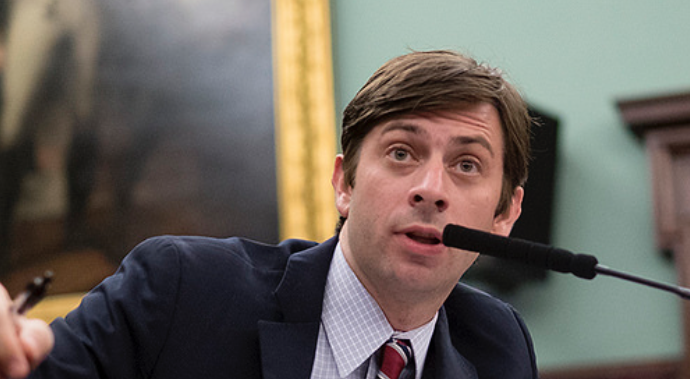
Incumbent City Council member Stephen Levin (Photo via City Council)
Councilman Levin, once thought of as a Democratic regular, has long since allied himself with the pragmatic school of progressivism whose standard bearer is the mayor. It also helps his cause that he’s affable, thoughtful and hardworking. But his support for using zoning, public assets, tax abatements and the like to accomplish his goals has attracted the anger of those who think there is some magic alternative method for the city to get things done.
It is perfectly OK to says that sometimes such goals must yield to other concerns. What is not OK is to pretend that you can have both. Cabranes has attracted the support of the magical-realist school of progressivism who believe you can, as well as NIMBY-ites of all political stripes.
There is something inspiring about Cabranes. Her story would make a great movie. Whether it will make for great governing is a different matter.
35th Council District
Incumbent Laurie Cumbo (Democrat/Working Families) is a paradox. In a city of rough edges, she exudes poise and class (she used to run an art museum). She has an intuitive sense of people and how to charm them and make them feel at ease. She remembers your kids’ names and their interests and she really seems to care.
A good politician makes you want to have a beer with them. Cumbo could sell you the tavern. She has, over time, committed some cringe-worthy public malaprops, large and small. But even those most likely to find offense in such statements, like the Crown Heights Hasidic leadership, find Cumbo to be someone they are very comfortable working with.
Cumbo is generally in line with her very liberal, very racially mixed district, but her affinity for the poorest members of her community has led her to support development which has often attracted fervent opposition. Most recently and dramatically this raised its head in the fight over residential development of the Bedford-Union Armory in Crown Heights. The development would include 330 units of new rental housing, about half of them classified as “affordable.”
Under pressure from opponents, Cumbo now says she opposes the development in its present form, but few believe she will oppose it in the end. In the recent primary, Cumbo faced a primary from Ede Fox, a smart former council aide and fervent opponent of the armory project, who got 42% of the vote and the support of hardcore progressives.
Development opponents and left-wing critics of Cumbo’s support for de Blasio-style progressivism have now rallied around the unlikely candidacy of Green Party candidate Jabari Brisport, who is also running as a Socialist. An actor who teaches at an SAT prep course, Brisport is a well-versed proponent of what a hard-left version of city government might look like (not much respect for the bourgeoisie concept of private property). He has attracted a lot of support from former Fox supporters and will probably attract a stronger vote than any Green candidate in the City.
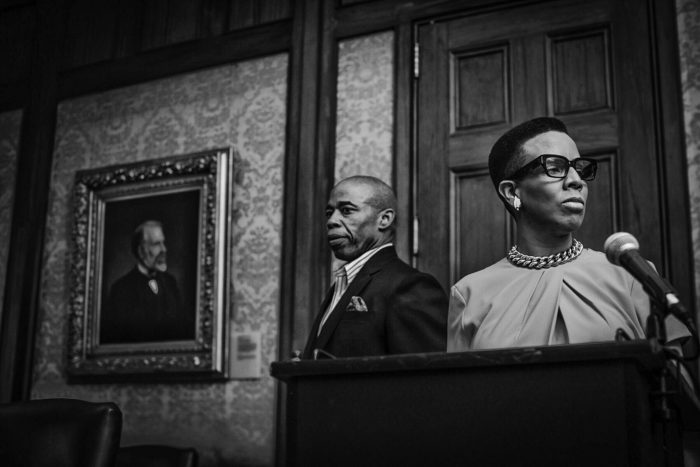
Incumbent city-council candidate Laurie Cumbo, with Brooklyn Borough President Eric Adams
There’s also a Republican, Christine Parker, whose background in the arts world is remarkably similar to Cumbo’s. Her main focus is on school vouchers, and she has actually been campaigning. Kudos to her for actually making the effort, but she will likely come in third.
37th Council District
This Bushwick/Cypress Hills-based district meanders a bit into Queens. Incumbent Rafael Espinal Jr. (Democrat) was once portrayed as a socially conservative political flunky by people like me, but now projects as a smart, earnest young man with a great future. His endorsement last year of Bernie Sanders baffled friends and foes alike, while some of his pet causes, like the well-being of Holocaust survivors, would seem to convey him no political development (even if he were to run for higher office, many of those he’s championed are so old they may well be gone by then).
His opponent, the Green Party’s Persephone Sarah Jane Sanderson-Smith is frank in her preference for Jill Stein over Bernie. Her Green Party candidate statement says she’s “a versatile musician, who plays the trumpet, trombone, piano, violin, bass, and guitar. She has played in ska, reggae, and punk bands. She loves surfing, video games, and comics.” Her political priorities, according to city’s Campaign Finance Board Voter’s Guide, are affordable housing, education, anti-gentrification and community sustainability. A formerly homeless Navy veteran, if elected she would be the first transgender member of the City Council.
38th Council District
Incumbent Carlos Menchaca (Democrat/Working Families), one of the council’s most left-wing members, has just survived a primary against four more-moderate candidates, including Felix Ortiz, normally considered an extremely liberal assemblyman. Last-place primary finisher Delvis Valdes, despite a long record as a community activist, attracted most of his attention in the race for his seemingly less-than-sterling record as a landlord. He is now on the ballot as the Reform candidate. The Conservative Party is running Allan Romaguera, who is making his 8th run for public office (usually as a Republican) without seemingly ever spending a cent or articulating a position in public.
The only Menchaca opponent actually making a race of it is the Green Party’s Carmen Hulbert, a former Bernie Sanders delegate occupying the tiny space of the political spectrum to Menchaca’s left. Perhaps if Menchaca had lost the primary, Hulbert could serve a similar function to Jibari Brisport in District 35, but it is hard to see what point she is making in this race.
40th Council District
Incumbent Mathieu Eugene (Democrat) first won election to this seat in 2007 in a special election with the support of his predecessor, Yvette Clarke, who’d been elected to Congress. He won his second election to the seat a few weeks later, after he refused to sign sworn documents saying he lived in the district at the time of the election and the seat was again declared vacant, forcing the seat to pay twice for the costs of the special election.
Whether Eugene actually lives in the district is still an open question, but he can truthfully swear that he rents an apartment there. Haitian-born Eugene is graduate of a Mexican medical school, but has never been licensed to practice medicine in the U.S. Progressives have never been fond of Eugene, who, before his election, sometimes contributed money to Republicans and has never shown great enthusiasm for pet causes of progressives.
Or anyone else’s pet causes. Progressives are not alone in their disdain. On primary day this year, despite his decade of service (or, more likely, because of it) almost 60% of the voters of his district voted for someone else. But they were divided three ways, among candidates with relatively similar messages.
Eugene’s runner up, Brian Cunningham, a former legislative aide, is still running, on the Reform line, and he’s running a real race. He recently acquired the support, but not the ballot line, of the Working Families Party. Though it’s not very likely, Cunningham has a chance of winning. Also theoretically in the race is Conservative Brian Kelly, making his 8th run for office since he first started in 1970. As usual, Kelly’s campaign ended when his petitions were filed, and his most likely impact will be to bleed a few votes away from people who confuse him with Cunningham.
41st Council District
Alicka Ampry-Samuel (Democrat/Working Families), a former Democratic district leader and legislative aide who won the primary for this East Brooklyn district faces off against against Berneda Jackson (Republican/Conservative) and Christopher Carew (Solutions). In an interview with now-defunct DNAinfo, Samuel said her top priority will be affordable housing to her district, including programs to help residents buy their homes. “I would like to see housing in the district that speaks to mixed income for everyone, as well as options to purchase a home,” she said. “Housing is everyone’s focus right now, so it has to be my focus.”
Jackson is on her third try for office after two runs for the assembly seat that largely tracks this district. Each time, she got barely above 2% of the vote. She is at least pretending to run a campaign. However, she told the Brooklyn Daily Eagle,“I’m going to advocate for a stronger Social Security and Medicare safety net for our seniors,” suggesting she is out of touch with the limits of what the City Council actually does.
Carew, who claims to have founded a flea market and an apparel company, attempted to run in the Democratic primary, but did not make the ballot, nor did he manage to submit a statement for the Campaign Finance Board Voter’s Guide, so it’s hard to conceive that he can really manage a solution to anything, though it appears he is obsessed with urban farming.
42nd Council District
Charles Barron, who once held this seat, is perhaps most famous for saying he wanted to slap a white person for his mental health. Anyway, that’s just the tip of the iceberg, which includes spreading lies about poor old Jimmy Carter.
While he occupied the council seat, the local assembly seat became vacant and Barron helped elected his wife Inez to the job, so that she could hold the slot until he got hit by term limits, and then switch jobs with each other. I guess sending Charles to Albany was a good thing. Meanwhile, Inez (Democrat) is the council incumbent. She thinks a lot like Charles does, but is a lot quieter, which is a blessed improvement.
She is opposed by Mawuli Hormeku on the Reform line. Hormeku also ran against Barron in the primary and got 16% of the vote. According to his website, his priority is “L.O.V.E.”, which stands for Legacy, Ownership, Vocations and Education. What a novelty: a candidate for the 42nd district who preaches L.O.V.E. instead of hatred. Also in the race is Conservative Ernest Johnson, now on his 12th race for public office without ever hitting 5% of the vote.
43rd Council District
Justin Brannan (Democrat/Working Families), formerly an aide to Councilman Vincent Gentile, faces off against John Quaglione (Republican/Conservative/Independence), currently an aide to State Senator Marty Golden. This may be the only real Democratic vs. Republican race in Brooklyn this year (there is arguably one more, in the 48th district).
Also in the race is Republican Primary loser Bob Capano (a Reform candidate and former aide to former Congressman Vito Fossella), now causing agita for Quaglione by still showing up at debates and outflanking him on his right. To balance this off, someone managed to qualify Angel Medina, who lives far from the district, as the only Women’s Equality Party candidate in the borough, but there’s no sign that anyone is aware that he’s running.
Quaglione once ran unsuccessfully against Gentile for City Council and, if elected, would be the GOP’s anointed one to take over the Senate seat in the event Golden retires. He’s a fairly standard-issue Bay Ridge Republican of the old school whose basic platform is Bring Back the ’50s, and they mean Pat Boone, not Fats Domino.
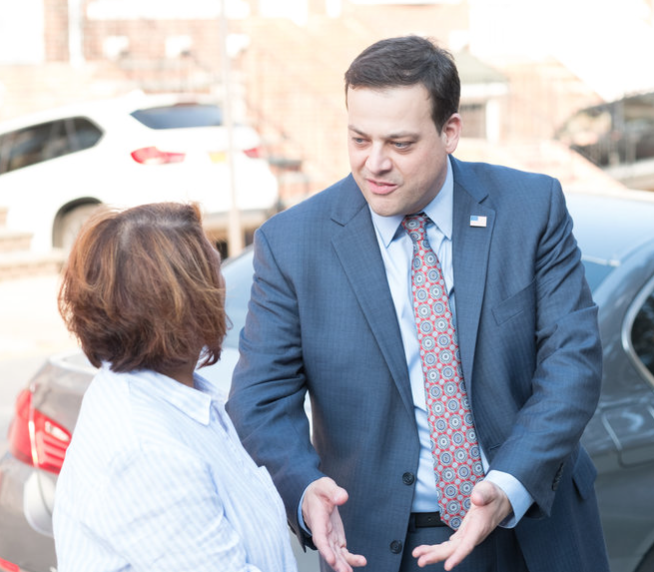
John Quaglione, Republican candidate for City Council from Bay Ridge
But the rocker in this race plays a very different sort of rock ‘n’ roll. Yes, Justin Brannan played and sang in a hardcore band. He has also worked on Wall Street. He is what old-school Bay Ridge looks like in the 21st Century. He is a Democrat of liberal instincts, but with the sort of caution old Bay Ridgers think of as common sense. Justin is Bay Ridge through-and-through, so he may be the one guy who can understand both ends of this rapidly changing neighborhood, where the old guard still holds sway—for now.
44th Council District
Last year, Assemblyman Dov Hikind, who represents most of this area in Albany, pulled a neat trick. He filed petitions to run for re-election to his position as the area’s disloyal Democratic State Committee member, and then, once sure he was unopposed, he filed a declination and used his petition’s Committee to Fill Vacancies to handpick his successor without his having to face a contested election.
Now, someone else in the area pulled a similar stunt and Hikind is furious. Unable to sue for copyright infringement, he’s running his son Yoni (a social worker who let his license lapse after his father got him a job with an agency he’s obtained funds for) with the City Council.
David Greenfield, an incumbent council member who was unchallenged for re-election, filed his petitions and then accepted a high-paying job at the Metropolitan Council on Jewish Poverty. He then substituted his protégé, Kalman Yeger, an attorney who has worked for various elected officials, and who was running for a different seat until the substitution.
I would normally have suspected the substitute was completely premeditated, but by pure accident, I know the truth. The last night to file petitions, I attended a wake in Bay Ridge. Leaving after a decent interval, I picked up a charcoal-smoked pastrami sandwich at Jay and Lloyd’s in Sheepshead Bay and decided to eat it over at District Leader Lew Fidler’s nearby clubhouse, which I had not visited for over half a year.
Walking in to the surprise of those present, I discovered a big meeting concerning Kalman Yeger’s campaign against Chaim Deutsch (the seat next to Greenfield’s) was about to commence. Kalman arrived, having just been knocking on doors. Then came Greenfield, who basically ran the meeting along with Fidler. It was intensive and comprehensive, focusing even on minor items like targeted mailings. Although it later became clear that Greenfield knew at the time that he was in the running for a new job, what I witnessed were not the actions of a fake campaign.
Unlike other instances where this has taken place, the consequences are not conclusive. This is a district (including parts of Midwood, Borough Park and Bensonhurst) where Democrats lose as often as they win in federal, state and citywide races. So when Yeger switched races and Hikind decided to run his son on a line they called “Our Neighborhood,” Yeger had a real race, even with both the Democrat and Conservative lines.
Hikind and Greenfield, despite both being devout Jews focused on the peculiar issues of ultra-Orthodox Jews, are very different flavors. Hikind’s original official biography began with a racially charged narrative about changing neighborhoods. And in recent years, he attracted notice for dressing up in blackface for Purim. In Albany, he doesn’t even bother serving on a committee and seems more interested in being a tribal chieftain than a legislator. He devotes more effort to funneling money to right-wing parties in Israel and to groups which create jobs for his offspring than in doing his mundane legislative homework By contrast, Greenfield is a bright, bread-and-butter legislator who runs the Land Use Committee and engages comfortably with the wider world.
This seems to be mirrored in their choices for council. Yeger is no flaming liberal, but he is a traditional Democrat on economic issues and has worked for more than one minority elected official. By contrast, Yoni Hikind seems to have been cloistered even within his cloistered world. Some secular supporters have have been saying that his social-work training has made him something of a relative liberal, and that he has little interest in stirring up hatred on social issues. But if this is true, he’s keeping quiet about it, while his campaign spreads wild rumors that Yeger has been endorsed by Linda Sarsour.
Some have questioned whether Hikind is up to the job. The Daily News called him “out of his depth.” Even those who may be uncomfortable with an insider as consummate as Yeger may have met their limits in this race.
There’s also a third candidate, Harold Tischler (School Choice), most noteworthy for doing federal time for immigration fraud, and for being the father of Abe and Mo, two young Borough Park political upstarts.
45th Council District
Incumbent Jumaane Williams (Democrat/Working Families) has been a substantive legislator, with a strong personal narrative (he suffers from Tourette’s), who has courageously pursued sticky issues like police misconduct. But he has had a streak of socially conservative views on marriage equality and abortion which he has problems grappling with. This helped sink his efforts to become council speaker four years ago and was doing the same this time around.
Williams’ only opponent, Anthony Beckford, is enrolled as a Democrat, but also identifies as a Green. He’s running in the very tiny space to the left of Williams on economic issues, but was also running in the large space to Williams’ left on social issues. This wasn’t going to win Beckford the election, but it at least gave voters who cared an outlet for their protest and gave Beckford a rationale. But on Oct. 26, more in response to the speaker’s race than this election, Williams gave an interview to Gay City News and announced his evolution on both choice and LGBT rights.
46th Council District
Alan Maisel (Democrat) is everyone’s nice Jewish uncle, a hardworking legislator acutely attuned to the bread and butter concerns of his district. His only opponent, real-estate broker Jeffrey Feretti (Conservative), is on his fifth race for local office. Back when the GOP bothered to back him, Feretti did as well as 26% and made some show of actually campaigning. Those days are apparently over.
47th Council District
Incumbent Mark Treyger (Democrat/Working Families) faces Raimondo Denaro (Republican/Conservative), an actual party activist, who is president of a Republican club. Treyger is a cautiously moderate-liberal southern Brooklyn Democrat, about as close to a progressive as this eclectic and changing area will currently abide.
Denaro is a fire-breathing Trumpian true believer that we are living in a dystopian wasteland, who thinks that every day brings us “tragedy after tragedy.” Denaro says “drug crimes and death are becoming the norm.” This would be arguable if he were running in Brownsville, but he’s running in Bensonhurst. Denaro wants to return us to “how things were before.” The man doesn’t need a council seat. He needs some Prozac.
48th Council District
Incumbent Chaim Deutsch (Democrat) is being challenged by Steven Saperstein (Republican/Conservative/Reform). This area, which runs from Midwood south to Brighton Beach, has a history of supporting Republicans in federal, state and citywide races. Deutsch is one of the council’s most conservative members, but he keeps being opposed by people to his right. In the primary, he faced an opponent, Marat Filler, who circulated literature accusing him of being pro-LGBT, when it would be more accurate to say Deutsch is more interested in filling potholes than trumpeting his socially conservative beliefs.
And in the general, he faces a real campaign from Saperstein, although one would have trouble fitting a caraway seed in the space between their differences on the issues. The GOP strength here lies in the Russian and Orthodox Jewish communities. Saperstein is neither, while Deutsch is practically a Satmar without a beaver hat. Plus, the Russian leaders who opposed Deutsch last time out are now mostly in his corner.
Could an anti-de Blasio landslide here bring in Saperstein on its coattails? Possible, but not likely. De Blasio lost this district last time and Deutsch still won, against a stronger Republican.
Special Election: State Senate District 26
Daniel Squadron, elected as the very model of a Brownstone reformer from this Manhattan/Brooklyn seat, resigned his seat in midterm, too late for the seat to be filled in a primary. After intrigues which would have shamed the Borgias, and an interpretation of the party rules utterly without precedent, Democratic leaders concocted a nominating process in which the guy who lost the nominating convention 72% to 28%, assemblyman Brian Kavanagh, got the nod.
Kavanagh (Democrat/Working Families) is opposed by Analicia Alexander (Republican) an associate bilingual pre-K teacher at the Berkeley Carroll School in Park Slope. Alexander isn’t even pretending to run a campaign, but I’m predicting she does even less well than Kavanagh did at the nominating convention.
A Brooklyn Insider’s Guide to This Week’s Elections
By the end of Mayor de Blasio’s recent town-hall meeting in Brooklyn Heights, there were quite a few empty seats. One couldn’t help thinking that maybe more people would have been there if only there were an election going on.
But of course, in the technical sense, there really is. In fact, the mayor has six opponents.
Yet, despite the lurid accusations of mayoral pay-for-play spilling out in recent days from the mouth of a skeevy developer-turned-government-witness, it’s too late to stop the mayor’s momentum. In the political world, his troubles are regarded mainly as a missed opportunity for potential opponents and political consultants.
The mayor beat the most significant opponent to cross his path; his name is Preet Bharara. As Hillel the Elder once opined, “the rest is commentary.”
And the same lack of suspense is present in almost every other election taking place on Tuesday, both citywide and in Brooklyn. No wonder that one of the hottest movements right now in progressive New York City circles is one encouraging city residents with second homes in the Hudson Valley, upstate and on Long Island to register to vote from their vacation residences, where their votes might actually make a difference.
The few real contests are probably at the City Council level, with at least two races where the results are in doubt, and arguably a few others where candidates other than the Democrats are working their hearts out. But there are some citywide, boroughwide and local races which offer a few laughs on their own merits.
As a former political blogger with some expertise on the Brooklyn scene, I’ve been asked by The Bridge to put together a tip sheet on what’s on the ballot for Brooklyn residents too impoverished to own a second home. Because, even in a fixed fight, you can’t tell the players without a scorecard. My tour of our local political menagerie:
The Parties
Besides our one and a half major parties, New York has six political parties that earned an automatic ballot line for four years by polling at least 50,000 votes for governor in the 2014 general election.
Small parties with their own lines can qualify candidates for the ballot with a mere 5% of their enrolled voters in a jurisdiction, a number which sometimes runs into the lower single digits. By contrast, parties without their own ballot lines face onerous petitioning requirements, which they nonetheless fulfill because it is so rare that anyone bothers to challenge their petitions.
They all occupy their own unique niches:
The Conservative Party’s function is to use its power of cross-endorsement to push the GOP to the right.
The Working Families Party’s function is to push the Democrats to the left and to serve as a money funnel for that purpose.
The Green Party exists as an outlet for those people who’ve given up on pushing the Democrats to the left, as well as those who never thought it was possible in the first place.
The other parties are less ideological, but have in common that their ballot lines are the accidental byproducts of gubernatorial elections past.
The Independence Party, created by a long-forgotten multimillionaire on an ego trip to become governor, now functions as a feeding trough for various opportunists, seeking to sell its appealing name to the highest bidder. Its primary function these days is to serve as a money sluice for the State Senate’s GOP-allied Independent Democratic Conference.
The Reform Party, started as an effort to give the last Republican gubernatorial candidate another ballot line, has been taken over by opportunists seeking to replicate the Independence Party’s success at accumulating contributions and jobs for the boys. This year, they’ve made a strange series of momentary alliances all over the ideological spectrum.
The Women’s Equality Party (WEP) publicly states that its purpose is to advocate for the passage of a 10-point Women’s Equality Act, but was started largely as an effort to give Andrew Cuomo another ballot line, and to draw him favorable attention at a time he was being challenged in the primary by a female candidate. (Members of the Working Families Party believe WEP’s name was chosen to have similar initials to its own, WFP.) In fact, the WEP has strenuously avoided running candidates anywhere in the city this year, and in the few races where it has (one in Brooklyn), they are either Republicans or people suspected of being Republican plants who’ve gotten on the ballot in spite of the party leadership’s best efforts to prevent their presence.
And now that we’ve laid out the playing field, here are the players in citywide and borough-wide races. (Read our guide to Brooklyn’s City Council races here.)
Mayor
Mayor de Blasio sees himself as a pragmatic progressive who actually wants to make things happen, rather than to stop them in their tracks. Looking in the face of what he sees as the daunting realities of no federal help and a budget constrained by needing Albany approval for virtually every revenue enhancement, he uses what tools he has: zoning variances and rezoning, selling off public assets with strings attached, tax abatements and other tricks of what could be called “progressive extortion.”
Such methods have become the coin of the realm for getting new schools, library improvements, parks and affordable housing. It is of course a modus operandi with both limits and pitfalls and it has attracted critics from all along the political spectrum.
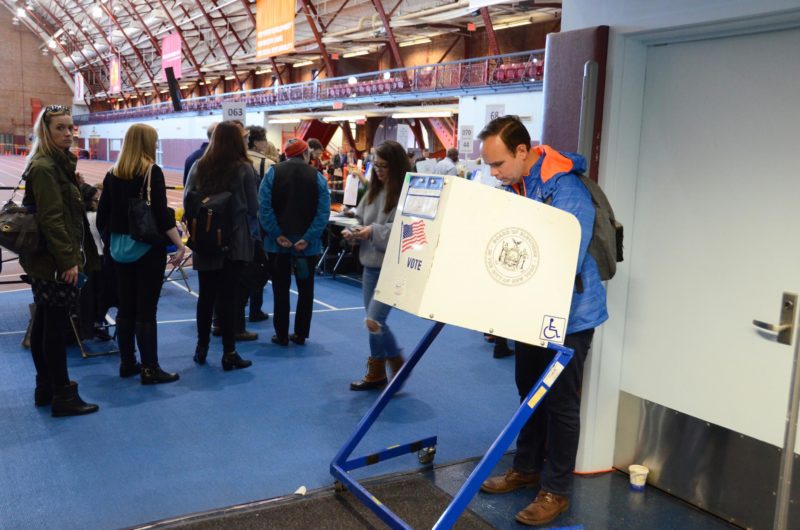
Voters casting their ballots at the Park Slope Armory in last November’s election (Photo by Simon Leigh/Camera Press/Redux)
Opponents of this school of progressive thought have raised many critiques. Good government groups rightly worry it fosters corruption. Some, to the mayor’s right, oppose his goals.
Critics to the mayor’s left don’t like the limits and don’t like the consequences, especially what they see as encouraging overdevelopment. Some of the concerns they raise are valid, but what liberal critics haven’t raised are any plausible alternatives to meet the goals they profess to share.
De Blasio is opposed on political-party ballot lines by Assemblywoman Nicole Malliotakis (Republican/Conservative), Akeem Browder (Green) and former Councilman Sal Albanese (Reform).
In addition, Malliotakis also circulated petitions to attain a “Stop de Blasio” ballot line. This is not to be confused with the “Dump the Mayor” ballot line occupied by celebrity private eye Bo Dietl, notable for his appearance as the arresting officer in Goodfellas, in which he displayed more restraint than he showed in the first candidates’ debate.
To be fair, Malliotakis’s dis-da-mayor line is being used to help other GOP candidates throughout the city, while Dietl’s, like virtually everything else about his campaign, is an exercise in personal self-aggrandizement.
Rounding out the field are Libertarian Aaron Commey and Democratic primary also-ran Mike Tolkin on the “Smart Cities” line. (Tolkin failed to run last in the primary and is now giving it another try; here’s betting that this time he succeeds.)
Whatever one thinks of the mayor, and I would not say I’m a big fan, he seems to be the only candidate in the race with more than a minimal clue about how to run a government. He’s not likely to lose, and even if there is a strong protest vote, it’s going to divide six ways.
Since there is little danger of any of the candidates challenging him actually managing to win, a protest vote can do no harm, and there are certainly more than a few things to protest. But the idea of a protest is to be heard, and the best chance of being heard is to put all the protest eggs into the strongest basket. Normally, that would mean Malliotakis, who, along with Albanese, has at least a minimal clue about how to run a government, as opposed to the other four choices, who have virtually no clue at all.
For most New Yorkers, a Malliotakis protest presents at least two problems. One is the perception that there’s no there there. Being in the Assembly minority leaves one free to go off on one’s own frolics, since your participation in legislating is outright discouraged, but prior to her race for mayor, Malliotakis was most notable for her effort to ban fake dog testicles.
Crain’s New York Business, a publication one would expect to be in sympathy with her agenda, asks “How can Malliotakis be this bad of a candidate?” and opines “She has offered not a single substantive policy in her campaign against de Blasio.” It followed this up with a “no endorsement” editorial. “She is not ready for the job,” stated the publication. “Given her minimal management experience, she ought to have made her campaign one of big ideas. Yet she has not proposed a single one.”
Those who want to base their protest on ethical, but not ideological grounds, may find solace in the mercurial Albanese, who is equally comfortable supporting Bernie Sanders and right-wing GOP State Senator Marty Golden. Albanese swings at the mayor from both the left and right, and averages out close enough to him to suffice for those who dislike the mayor more than his policies.
Those wanting to send a more proactively progressive protest vote may prefer to support the Green, Akeem Browder. Yes, de Blasio generally stands at the left end of the politically feasible on any issue not involving a contributor or favored interest group, but progressives are rarely satisfied with what is politically feasible. Those who want to move left, but not too far, can always split difference between Albanese and Browder by voting for Tolkin.
And those fed up enough with city government to want to kick over the apple cart entirely have two choices: Dietl, our own home-grown Trump, or the libertarian Commey, who once attempted to hijack a plane to Antarctica, but is still thought by some to show fewer signs of nuttiness than Dietl.
So where does that leave us, given the likely outcome? The mayor becomes a lame duck on Day One of Term Two, but even without the impending end of power, New York has never been kind to second- and third-term Mayors. One can scarcely point to any mayor’s transformative initiatives after the first term. The smart money would bet on that not to change. So what can we expect from the mayor in the next four years?
Less of the same.
Public Advocate
Incumbent Letitia James (Democrat/Working Families) is opposed by Juan Carlos Polanco (Republican/Reform/Stop de Blasio), Michael O’Reilly (Conservative), James Lane (Green) and Devin Balkind (Libertarian).
Tish James is undeniably smart and certainly has enough of the characteristics of a pit bull to have the potential to be the sort of watchdog envisioned by the authors of the City Charter when they created the position. However, it cannot be said that she has been aggressive as one would hope in keeping an eye on the mayor. And her jumping on nearly every progressive band wagon, no matter how silly, has had its moments of annoyance.
If you’re not going to serve as a check on the mayor, it’s hard to see what the point of the job is. Except, for example, in the hypothetical situation in which a mayor gets indicted for some sort of pay-for-play transaction and gets convicted. In which case, the public advocate would become the acting mayor.
James’s major opponent, Polanco, actually sounds thoughtful, but his major public experience was as president of the NYC Board of Elections, which, except for the Parking Violations Bureau, would be the city’s most hated agency. Still, Polanco, who has always called himself JC, gets credit for having done more in the way of public outreach in that job than all of his predecessors and successors combined. No one ever put more lipstick on that pig than JC.
On the other hand, he wears a bowtie and spews out a tired combination of right-wing Republican talking points including abolishing Common Core, eliminating municipal ID cards, and keeping the Rikers Island prison open. But his plan for affordable housing (taking up three different sections of the issues page of his website) is ludicrous. Mostly, he advocates selling off our existing public housing to the current tenants, thus gradually eliminating our already insufficient supply. His solution to homelessness is mental-health care and financial literacy. No mention of permanent housing, and the only thing he says about shelters is we have enough of them. The actual section called “Affordable Housing” talks about improving transit, apparently so people can live elsewhere.
Yet that apparently isn’t enough for the Conservative Party. Their candidate, Michael O’Reilly, has similar priorities and positions as Polanco, but his Facebook page currently features links to the likes of Glenn Beck and Congressman Steve King. One gets the feeling O’Reilly would rather burn public housing than sell it to the tenants.
The Green’s Lane is pretty standard-issue, except he apparently has no idea where he is running, given his platform includes support for family farms, protecting farmland and a whole litany of ideas outside even the most liberally interpreted concept of local government.
Libertarian Balkind, an enrolled Democrat, seems a pretty strange Libertarian, even when compared to the party’s mayoral candidate. A party committed to property rights has a candidate who wants to put intellectual property into the “public realm.” But most disappointingly, Balkind does not advocate the most commonsense Libertarian idea relevant to the job he seeks. To wit, he does not advocate its abolition.
It’s easy not to care one way or another, but since the occupant of this job could end up running the city, a vote for James would seem to be an act of prudence.
Comptroller
Incumbent Scott Stringer (Democrat/Working Families), who would prefer to be running for mayor, is opposed by Michael Faulkner (Republican/Conservative/Reform/Stop de Blasio), a former New York Jets player and current Harlem pastor and former Jerry Falwell protégé, who also would prefer to be running for mayor–and was, until the GOP leadership awarded him this consolation prize. Rounding out the field are Julia Willebrand (Green) and Alex Merced (Libertarian).
While neither Stringer or Faulkner really wants the job, Stringer actually has an idea what it does. Meanwhile, Faulkner seems to believe he can have an impact of “federal tax and spending fairness.” If this really were a priority for him, he’d quit the GOP.
Willebrand, a retired teacher and college instructor, seems to spend her time as the designated Green for state and city financial positions, even though her major concern seems to be environmental issues.
Merced is a novelty, as he has experience in the world of finance and seems most interested in performing functions which actually meet the office’s job description. This may be a first. I am impressed enough to recommend that Stringer consider hiring the guy.
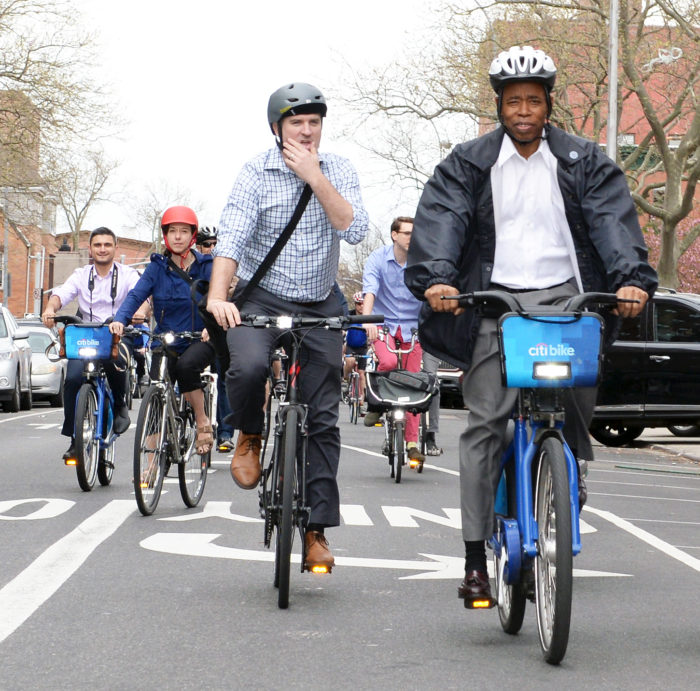
Adams, on board a Citi Bike, wants to lead Brooklyn into a healthier era (Photo by Erica Sherman/Brooklyn Borough President’s Office)
Brooklyn Borough President
The curious political journey of incumbent Eric Adams from police captain to Nation-of-Islam-allied militant to Gingrich Republican to reform-oriented liberal firebrand continues as he evolves further into his current occupation as non-controversial civic booster and champion of economic development.
Adams (Democrat/Working families) is opposed by Vito Bruno (Republican/Conservative) and Benjamin Kissel (Reform). Bruno has actually been postering so aggressively one would think he was the only candidate. He has also been doing robo-calls. Described by the New York Post as a “Nightlife Legend,” Bruno is the former owner of the Odyssey nightclub in Bay Ridge, most famous for its starring role in Saturday Night Fever. He also managed Studio 54, The Roxy, Palladium and Tunnel and has been a 30-year volunteer for the gay-pride parade. This is not your daddy’s Bay Ridge Republican.
Bruno feels he’s qualified for the job because he sees it as that of a promoter, and that’s what he does. Can anyone explain how this differs from Marty Markowitz?
Kissel, by contrast, calls himself “one of the nation’s rising political commentators” and does a podcast called Cave Comedy Radio. According to his website, “Ben is ready to get involved in his community to challenge the one-party rule of New York City politics and stand up for Brooklyn! One of Ben’s goals is to inspire other young people to run for public office to effect change in their local community. If Ben can do it, so can you!”
And who says we have no real choices?
District Attorney
After winning a six-way primary by a slim margin of 40 points, Acting DA Eric Gonzalez faces his 5th-place primary opponent, Councilman Vincent Gentile (Reform). It can actually be argued that Gentile had the most impressive showing of the also-rans, as he still showed he was king of his district. He was the only candidate besides Gonzalez to win any Assembly Districts, carrying several, despite a campaign based on the proposition that he was Mr. Clean compared to his opponents because he never worked for the Brooklyn DA’s office. In fact, Gentile was untainted by exposure to any criminals (outside of a few colleagues he’d encountered in the City Council and State Senate), having not prosecuted a case in over two decades.
Supreme Court
There are two seats and three candidates: incumbent Bruce Balter (Democrat/Republican/Conservative), Acting Supreme Court Justice Andrew Borrok (Democrat) and John Bruno (Republican/Conservative). Until September, Bruno was the Conservative Party candidate for City Council in District 43, a prime Republican target. Bruno didn’t want to be on the council, but was holding the place until the GOP could hold its primary. In a process charmingly but accurately known as “backfill,” he then accepted the nomination for Supreme Court judge so he could be replaced as a council candidate by the winner of the Republican council primary. Bruno may actually want to become a judge, but he’s made little effort to do so beyond accepting the nomination. However, he may enjoy a name-association benefit from Vito Bruno’s aggressive postering operation.
Civil Court
There are eleven candidates for the six countywide Civil Court seats. Five of them were found qualified by the New York and Brooklyn bar associations. They are incumbents Carolyn Wade and Robin Sheares (both Democrats), and non-incumbents Connie Melendez (Democrat), Patria Frias-Colón (Democrat) and Isiris Isela Isaac (Reform). They face one Democrat, one Democrat/Reform, one Conservative and three Reform candidates, only one of whom had the guts and integrity to submit herself to peer review (and she was rejected).
Referendums
(You must turn over the ballot to find them.)
Question No. 1: Should we hold a constitutional convention?
The single most important thing on the ballot. I’m for it, and refer you here for further explanation. Fears it would be controlled by Republicans are not well founded. Unfortunately, thanks to the near-unanimous opposition of the Albany Bi-Partisan Iron Triangle and the interests that prefer the status quo, Con-Con is goin’ down.
Question No. 2: Should we allow courts the power to reduce or eliminate the public pensions of officials convicted of felonies?
Can you believe this isn’t already the law? And all it took to put it in front of the voters was the convictions of legislative leaders from both houses and both parties. And you still don’t believe we need a constitutional convention?
Question No. 3: Do you want to create a forest-preserve land bank of 250 acres for municipalities who could request to use acres in the land bank to address bridge-and-road hazards, to drill water wells to meet drinking-water standards, and stabilize public-utility lines?
Before local governments could begin requesting acres in the land bank, the state would acquire 250 new acres to include in the forest preserve. The measure would also allow bike paths, sewer and utility lines within the width of highways cutting through the forest preserve.
New York’s “forever wild” forests have strong protections, which require a referendum before any changes are made to them. Land trades have happened now and then, with no real danger to the overall health of the wild forests, and sometimes even an advantage to them. Some citizens always oppose any change on the principle that anything “forever wild” should remain thus. But those open to some reasonable modifications should consider if this passes their muster.
Why New Yorkers Shouldn’t be Afraid of a Con-Con
In Martin Scorsese’s Casino, a group of mob bosses facing trial gather to figure out a hit list of potential witnesses. The discussion centers on their old ally, Andy Stone, the head of the Teamsters Pension Fund. Not one of the bosses at the table believes there is any realistic possibility that Stone will be turned as a government witness, but ultimately, the head man at the table, Remo Gaggi, settles the discussion by saying:
“Look … why take a chance?”
Decades ago, Kevin Phillips, a leading conservative intellectual, came up with the term “reactionary liberalism” to describe the tendency of many liberal interest groups and politicians to be more concerned about circling the wagons to ensure the preservation of the governmental status quo than they were in advancing actual progressive values.
It is perhaps best expressed as the triumph of “Change we can avoid” over “Change we can believe in.”
And this tendency has no more illustrative embodiment in today’s New York State than in the organized opposition to a Constitutional Convention, an opposition that includes virtually every public employee union and liberal interest group.
Every 20 years, the State Constitution requires a referendum on whether we are to have such a convention, where 204 elected delegates would have the opportunity to amend the founding document. Not since the 1930s has such a referendum passed. (There was a convention in the 1960s, initiated by the legislature in response to the peculiar circumstances of the times, but the electorate voted down its recommendations). In the election on Nov. 7, we get another chance to vote for a Con-Con, and one would think, with our dysfunctional state government, there’d be a loud clamor for such a gathering among those who call themselves “progressives.”
One would think wrong.
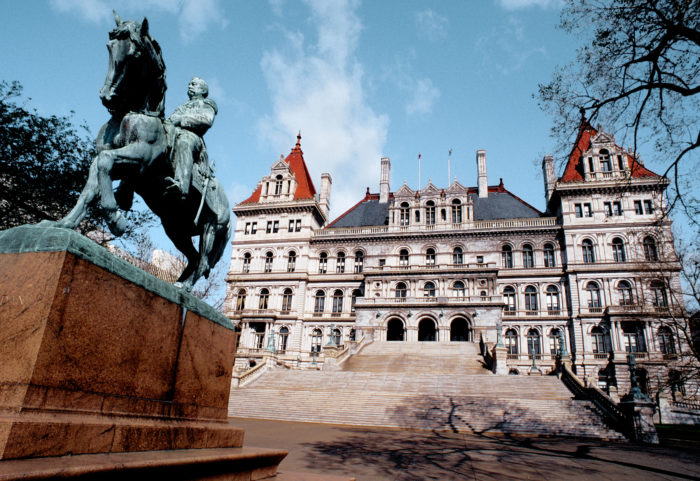
New York State’s capitol building in Albany, where delegates to a constitutional convention would gather in 2019 (Photo by Sandra Baker/Alamy)
Of course, the opposition is far broader than just the left; also opposed are the Republican Party, the Conservative Party, the NRA and the NYS Right to Life Committee (for once on the same page as Planned Parenthood).
But, reactionary reactionaries are commonplace, while reactionary liberals are supposed to be some sort of a novelty. Yet it’s the instinct of all elements of the political establishment (whatever their ideology) to avoid taking chances.
Who’s in Favor
Gathered in support of a Con-Con, against the weight of the political establishment, are good-government groups like the League of Women Voters, young fans of Bernie Sanders, and a few interest groups who’ve given up any hope of seeing their concerns addressed by the status quo, most notably Bar Associations looking for reform of New York’s byzantine court system. Also: the hopelessly outnumbered Assembly Republicans, willing to grab onto any change, and a handful of idealistic conservative activists, mostly intellectuals.
But the real power structures are all on the con side of Con-Con. Public-employee unions, for example, are attached to the current Constitution’s strong protections for their pension rights. But the notion that a convention would endanger such provisions, while theoretically possible, is highly unrealistic. The likelihood of a New York Con-Con proposing to harm union employees, and New York voters ratifying such changes, is about as remote as a Nevada Con-Con banning casino gambling.
The fears of other liberal interest groups are similarly overstated. Instead of the predicted nightmares, we are more likely, in bluer-than-blue New York, to see an effort to guarantee the right of New York’s children to what New Jersey’s constitution calls “a thorough and efficient education,” as well as some effort to guarantee a constitutional right to affordable housing, or to strengthen abortion rights.
Democrats Would Dominate
Liberals are scared because liberal interest groups have been running a scare campaign based on the notion that the convention would be a financial boondoggle dominated by Republicans and special interests. But experts like SUNY New Paltz political scientist Gerald Benjamin disagree: “Republicans are diminished in numbers in New York … and Republican districts are very closely divided and, consequently, divided outcomes will favor Democrat,” he said. “All credible analyses of the outcomes of the election done by neutral political scientists or social scientists show there will be a Democrat majority at the convention.” If voters approve a Con-Con, they’ll vote for delegates in November 2018, the convention would take place in Albany the following spring, and their proposals would be put to voters the following November.
However, as much as the fears raised by the prospects of a convention are exaggerated, so are the hopes.
Delegates to the convention, elected under our current system of party primaries and general elections in which interest groups will take an interest, are mostly going to be establishment pols from both sides of the aisle. It is unlikely that radical reformers from either side will be able to do much beyond forming coalitions on non-ideological issues.
Why It’s Worth the Risk
So the fears and hopes are both exaggerated, but a convention is still worth having. Not every necessary operation is about life or death–sometimes there is a need for a colonoscopy.
A constitutional convention, even made up of the same types who populate the legislature, is far more likely than a legislature to produce some changes for the better. There are a lot of factions of people around the state with a lot of interests who will be working outside the normal framework, and on stuff usually ignored. The pressures of the budget and pressing-headline issues will mostly be absent. The “big ugly” sort of deals, where everything gets thrown into a package hinging on the budget, will be gone.
The issues that get ignored because they aren’t pressing and are on no one’s must-list will largely be the convention’s subject. Court reform, which is always ignored, and which is not really ideological, will be possible. Changing the budget process to eliminate the overwhelming power imbalance in favor of the governor will not only be possible, but likely. Reapportionment to reduce gerrymandering? This is an area where things really can only get better and have at least a semi-plausible shot at happening.
Stronger home rule might also be accomplished. In a non-legislative session with a good bloc of non-legislators, as well as legislators so inclined, urban delegates could join with like-minded suburban representatives to change the rules that require local governments to get legislative approval for every little thing.
So the convention will largely be unglamorous, but it may be our only real hope for changes in the way government works in New York. We can assume it will be a convention mostly run by pros, but a lot of pros have been waiting for an opportunity to fix what they know is wrong.
This is that opportunity.
We got health-care reform from a president who ran on “Change we can believe in.” It wasn’t perfect because the process was still political, but things improved. I can’t tell you for certain that a constitutional convention will improve things, but I can tell you we will never get any improvements from people whose mantra is “Change we can avoid.”
How Bre Pettis Has Left His Mark on Downtown Brooklyn
This week, Bre Pettis, the co-founder of MakerBot and one of Brooklyn’s most creative entrepreneurs, will step down as co-chair of the Downtown Brooklyn Partnership (DBP). This is a natural progression of leadership for a civic organization that periodically hands the torch from one steward to another. However, what Bre’s leadership helped the Downtown Brooklyn Partnership to accomplish during his nearly four-year tenure is truly remarkable.
Bre was a reluctant convert. In 2012, confronting a steadily increasing office vacancy rate in Downtown Brooklyn, the board of directors of DBP handed me one overarching mandate as president of the group: turn the vacancy rate around. As we considered new asset-management strategies and ways to recast the attractive qualities of our local office market, my colleague at the time, Tom Conoscenti (now an administrator in the Cuomo Administration), had another idea. We should just roll up our sleeves, he said, and go visit some of the area’s largest employers to see if we could convince them to come to Downtown Brooklyn.
His One Simple Request
Bre, who was running MakerBot from Boerum Hill at the time, took our meeting. But his wariness of government assistance in the private sector and his reluctance about Downtown Brooklyn was evident from the start. After a few months of wooing, we won him over and he moved Makerbot’s Headquarters to MetroTech, helping to pave the way for other creative companies like Tough Mudder and Slate magazine to join the campus. Even more traditional players like NYU and JP Morgan soon began to sit up and pay attention again to changes in the area. NYU announced a $500 million expansion of its Downtown Brooklyn presence and JP Morgan soon after doubled down on its Brooklyn assets.

An aerial view of downtown Brooklyn’s rising skyline of residential and office buildings (Photo credit: Richard Cavalleri/ Shutterstock.com)
At the time Bre made me promise only one thing: that we would work to open more bars in the area, a seemingly trivial request. But even then, he understood that for Downtown Brooklyn to succeed we needed more amenities and gathering spaces to attract innovation companies to the area. And I knew we needed him involved with the partnership. He became co-chair soon thereafter.
During Bre’s tenure, the local office market absorbed more than 1 million square feet of vacant space, bringing thousands of jobs and important investment to Brooklyn, and lowering the area’s office vacancy rate to historic lows. Even after Bre sold MakerBot, he stayed close to home and began new ventures in the Brooklyn Navy Yard, in the heart of the Brooklyn Tech Triangle that he helped create.
Bringing Up the Next Gen
He also doubled down on his engagement with turning Downtown Brooklyn into a center for innovation, creativity and entrepreneurship. He pushed us to create real partnerships between local colleges and universities and the private sector which led to the creation of the Brooklyn Education Innovation Network. And he was not shy about pointing out to students that while college may be the way many students get access to technical tools, he urged them to make things that will impress firms. Good grades alone are not enough in today’s highly competitive and fast moving economy. It’s ideas and execution that matter.
He conceived of the Make It in Brooklyn Summit to highlight the world-class talent and ideas emanating from Brooklyn. And in the conference’s first year, it produced the definitive founder’s story discussion between Bruce Ratner and David Walentas, that for posterity alone belongs in the Brooklyn archives.
He thought it was important to seed the next generation of entrepreneurs in Brooklyn. And to do it, he volunteered his own money (as did his Co-chair MaryAnne Gilmartin of Forest City Ratner Companies) to help kick off a successful series of pitch contests to help fledgling businesses in Brooklyn, often supporting minority and women entrepreneurs–the authentic face of Brooklyn–in the process.
On a personal level, he was always encouraging, but discerning and direct, and erring on the side of courage. His work with Downtown Brooklyn was never about ego, but about what would create opportunities for Brooklynites.
But don’t worry, Downtown Brooklyn will go on without Bre in charge. His co-chair Gilmartin remains at the helm of the board. With the talented Regina Myer now in place as DBP president, the organization remains in capable hands. But if you see Bre on the streets of Brooklyn, give him a high five or a hug, and thank him for his service to Brooklyn. He deserves it.
Why the BQX Steetcar Will Bring a Better City
Does the Brooklyn-Queens waterfront region need its own streetcar? The announcement of the Brooklyn-Queens Connector (BQX) by Mayor de Blasio in 2016 has trigged passionate debate on the merits of the 17-mile, $1.7 billion project. Rightly so: an undertaking this complicated–and a vision this grand–are worthy of thorough discussion. However, I want to highlight three things that could help put this initiative in perspective, since I fear at times the block-by-block wrangling over the details of this project is eclipsing the bigger picture.
First, the BQX is not just some shiny new toy. The larger purpose is economic development, the biggest such proposal for Brooklyn and Queens in a generation. A valid historical comparison is the construction of the East River bridges in the 19th and 20th centuries, which unlocked opportunity for millions of New Yorkers by providing East-West connections that helped to solidify the economic ties between the city’s population centers. The BQX would be the comprehensive transit solution we need to unite the Brooklyn-Queens waterfront, creating a North-South spine that will lay the foundation for a future with more jobs, affordable housing, and office space.
Second, we are in the midst of unprecedented growth in Brooklyn and Queens. If you look at demographic data, as well as employment and residential growth trends, what emerges is all the makings of a labor force and creative-talent pool that no longer needs to commute to Manhattan to pursue their enterprises. These drivers of the new economy are already feeling at home in neighborhoods like the Brooklyn Tech Triangle and Long Island City. Just wait until the BQX unites these employment hubs and makes them accessible for the residents of Red Hook and Ravenswood.

The BQX streetcar zipping past Industry City along Third Avenue, in a rendering
Finally, an idea of this magnitude inevitably runs into all manner of obstacles and competing agendas. Navigating them takes courage and vision. Mayor Bill de Blasio and Deputy Mayor Alicia Glen should be applauded for having the guts to undertake this effort. Vocal detractors will tell you this project cannot and should not be done. They fail to point to the positive effects of the streetcar and light-rail renaissance around this country and all over the world.
Critics cite a single leaked internal memo–in draft form–about cost projections. OK, that’s part of the discussion too, but critics neglect to mention that these figures do not take into account the myriad solutions that may be explored, which range from streamlining construction methods to lining up more sources of capital. Contrary to the innuendo this memo launched, what the document actually demonstrates is the presence of due diligence being undertaken by city officials. This should provide all of us with comfort that the project is getting the scrutiny it deserves.
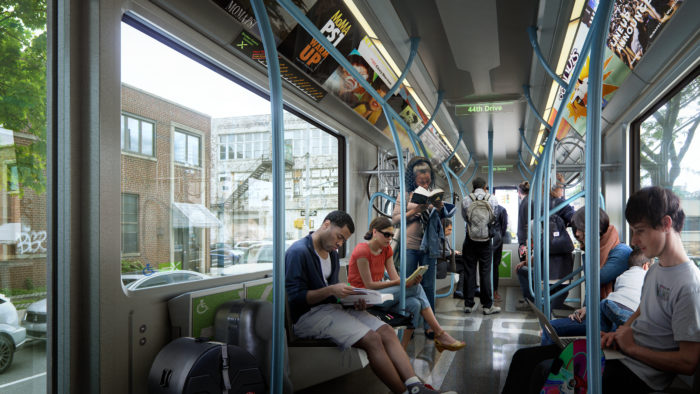
Inside a car of the proposed BQX, as shown in a rendering
The argument of detractors that transit dollars are better spent elsewhere is sleight of hand. Some say that new bus lines would be less glamorous and more effective, but the point of a streetcar is having a dedicated route and getting you faster from borough to borough. Some say there are more pressing projects that could use an immediate cash infusion, like long-called-for proposals for the Utica Avenue subway extension in Brooklyn. Yes, that’s a worthy project too. But what’s compelling about the north-south corridor connecting Brooklyn and Queens is that it’s one of the few routes where potential growth is sure to cover the cost of construction. This is what will allow it to be financed, without state or federal funding. These projects don’t need to impose either/or decisions on us. We should use capital spending to address pressing transit needs and we should look for opportunities to use creative financing tools on innovative projects like the BQX.
In the early 20th century, when the 7 subway line was first built to connect Queens to Manhattan, it was surrounded by largely vacant land. Today, it is one of the busiest subways in New York City and its presence paved the way for countless job and housing growth in areas like Flushing, Queens. While today’s Brooklyn-Queens waterfront is not in danger of neglect, it is plausible that left to market forces, the future of waterfront development in Brooklyn and Queens will be almost exclusively luxury housing, a terrible urban condition. The streetscape would be dominated by cars, taxis, Ubers, and private shuttles–and haunted by missed opportunities for job growth in industrial business zones like the booming southwest Brooklyn region.
With this proposal, the city has the opportunity to help create a more equitable community. Infrastructure like the BQX can connect long-isolated residents to job and housing opportunities. This is a big idea that should be applauded, one that lays the groundwork for growth for decades to come. Mayor de Blasio may face some heat for it today, but our children and grandchildren will thank him for it in the 22nd century.
Editor’s note: the writer is on the board of directors of the Friends of the Brooklyn Queens Connector.
A Simple Plan: Put Government to Work in East New York
In the last few months both Mayor de Blasio and Governor Cuomo have announced ambitious job plans for Brooklyn.
In his February State of the City address, de Blasio pledged to create 40,000 new jobs citywide over the next four years, with many here in Brooklyn, including a commitment to allocate $136 million dollars for a new center for garment manufacturing in Sunset Park.
In March, Cuomo announced a $1.4 billion plan for central Brooklyn to “finance more affordable housing, bolster access to medical care, increase jobs and expand youth and recreational programs.”
But perhaps the best place for both to start spurring job creation in Brooklyn is in East New York. And maybe the start of the solution is not hundreds of millions of dollars of government spending, but something as simple as relocating government jobs there.
Brooklyn Borough President Eric Adams has been calling upon the City to consider moving government agencies to the Broadway Junction area of East New York. The rationale would be to bring city services closer to the residents who need them. Additionally, the move would stimulate economic activity in the area by bringing jobs and commercial foot traffic to an area long in need of more investment.

The Broadway Junction transit hub has service from the A, C, J, Z, and L lines (Photo by Stan Wiechers/Wikimedia Commons)
The idea has a lot of merit. Broadway Junction is a significant transit hub for Brooklyn. Brooklynites in the surrounding area could more readily access government services if they were relocated closer to their communities there. Further, the economic activity generated by the presence of government offices in the area could be staggering. Private developers often have a hard time financing new commercial office buildings without first securing an “anchor tenant” to take a significant chunk of space. Government could provide that anchor tenancy, while paving the way for additional office space to be built on site for private companies to set up operations.
These government leases are key to helping private developers finance new office construction anywhere, particularly in neighborhoods lacking investment. But their power is not limited to helping to create new space to house jobs. Think of the thousands of office workers eating in local restaurants, shopping in local stores, drinking coffee and beer in local cafes, supporting the neighborhood economy with their significant daily buying power.
You would not have to look far for government offices to relocate there. Downtown Brooklyn alone contains more than 7 million sq. ft. of government-owned and leased space. The city and state have an opportunity to take stock of these real-estate assets and rationalize their use for the city we live in today.
There is more than 1.2 million sq. ft. of federal, state and city owned commercial space surrounding Cadman Plaza, notably the Brooklyn Municipal Building at 210 Joralemon St., the 65 Court St. building, and the Federal Building and Court House at 271 Cadman Plaza East. These architectural gems, of vastly different styles, could be re-purposed to create a new urban campus for entrepreneurs and start-ups drawn to the Brooklyn Tech Triangle, as well as new retail opportunities to inspire a better pedestrian experience.
By changing the tenant base of these assets, government could avoid having to spend additional money to renovate these aging facilities. Government workers could be consolidated on certain floors rather than whole buildings, or relocated to modern facilities in more efficient buildings built by partners in the private sector, particularly in neighborhoods in desperate need of economic development like East New York.
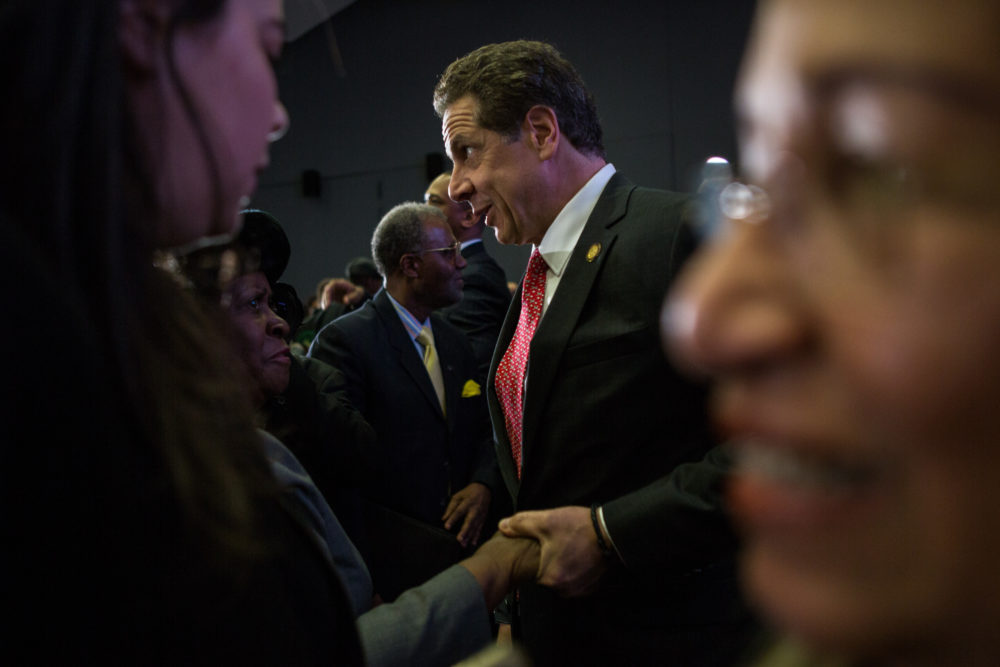
Gov. Cuomo after speaking at Medgar Evers College in March. He announced Vital Brooklyn, a $1.4 billion plan to direct resources to disadvantaged neighborhoods (Photo by Christopher Lee/The New York Times/Redux)
This policy–using government tenants to anchor new commercial space and re-position existing space–is a tried-and-true method. It worked for the original World Trade Center and its successor, as well as paving the way for MetroTech in Downtown Brooklyn a generation ago. Today, deals with government tenants at buildings like 95 Evergreen Avenue in Bushwick help make projects feasible.
The mayor and the governor should work with borough president Adams to identify government agencies that could take up residence in East New York, and then announce to the development market that they are open for business to anyone that can use their presence to finance new office construction in Broadway Junction.
Using city leases to generate high-impact economic development projects is a low-cost and smart first step in bringing opportunity to Brooklyn’s disadvantaged neighborhoods. The task would undoubtedly require coordination among city agencies, as well as with private developers and local stakeholders, but it could result in substantial and recurring benefits.
Brooklyn Pols Are Wrong About Cuomo’s Sales Tax Plan
As progressive as some of us pretend to be, none of us likes paying taxes, and we often embrace the old Russell Long dictum: “Don’t tax you, don’t tax me, tax that fellow behind the tree.”
Still, most of us will admit that, all things being equal, we prefer our taxes to be fair.
And what could be less fair than forcing some merchants to collect local sales taxes, thereby functionally raising their prices, while allowing other merchants to sell the same items without collecting sales taxes, thereby giving them a competitive edge?
Especially when that competitive edge disadvantages our locally based merchants (who provide jobs in our community and tax revenue to our state and local governments) and has the effect of shipping those jobs to another state.
Currently, brick-and mortar-businesses in New York State must collect state (and local) sales taxes from their customers. Online merchants based in NY must also collect state sales tax from their NY customers. Further, online marketplaces like Ebay and Amazon must collect state sales tax on transactions involving NY residents and NY merchants and other sellers.
Cuomo’s Proposal
A proposal by Governor Cuomo would up the ante and require online marketplace providers like Ebay and Amazon who do major amounts of business in the state (a minimum of $100 million a year) to collect NY sales taxes on behalf of merchants using their platforms who sell goods to NY residents, regardless whether the merchants are based in NY. The Cuomo administration estimates the change could bring in about $200 million in new state revenue over the next two years.
We might not like paying taxes we’ve avoided paying in the past, but Cuomo’s proposal would put all merchants selling to NY residents on a relatively equal footing. The effect would be to reduce NY state tax avoidance as a factor in our shopping decisions. The result: More money and jobs staying in our local economy.
Even so, you would naturally expect some legislators to oppose this, because tax avoidance is popular and tax compliance is not.
But you would at least expect them to have the decency not to claim that such a proposal would hurt the local merchants this proposal would actually help.

A worker gathers items for delivery from the warehouse floor at an Amazon distribution center (Photo by Ralph D. Freso/Reuters)
However, we are living in the age of Orwellian Newspeak, as our local Assembly members have now proven. The Daily News reported that the Brooklyn delegation to the State Assembly has recently released a letter it has sent to Assembly Speaker Carl Heastie, asking that the Assembly oppose the Governor’s proposal:
“The online marketplace has been a successful business model since the 1990’s [sic] connecting buyers and sellers for a small fee…” The letter points out that among the businesses is the Brooklyn-based Etsy, and that Amazon also has a warehouse in Brooklyn. Such businesses “have created much-needed jobs, tax revenue, and economic development opportunities throughout our state.”
But we are told the governor’s plan would set a “dangerous precedent for shifting regulatory and tax compliance from business owners to the platforms that host them” and put New York businesses at a competitive disadvantage. “We need to promote tech companies, not create regulatory liabilities.”
To which I must call baloney.
How It Really Works
If the plan somehow made online marketplaces collect NY sales tax on purchases by out-of-state buyers from merchants in NY, that would indeed put NY companies at a competitive disadvantage. It would be a highly counterproductive form of revenue collection.
But that is not what the Governor’s proposal does.
The Governor’s proposal actually helps NY companies, both brick and motor and web-based, by removing the perverse incentive for NY residents to buy online from out-of-state merchants to avoid NY sales tax.
And it creates no special disadvantage to NY-based internet marketplaces. The collection requirements would be the same for such marketplaces, whether they are based in Brooklyn or Boise.
So I have to wonder why these legislators are so concerned about a non-existent threat to NY-based internet marketplaces, but show no interest in the real concerns of the brick-and-mortar stores in their districts, many of whom are being driven out of business by those marketplaces. There will be heavy lobbying in this policy battle. Amazon and Ebay intend to put the full weight of their purchasing power to work stopping what amounts in their business to an administrative inconvenience. The longer-entrenched Retail Council, which represents merchants large and small, supports the Cuomo proposal. But in contrast to the internet giants, who could weather this additional burden, for smaller retailers it could be a matter of life and death.
So, why the letter from Brooklyn pols? It may come down to a saying by another famous politician, Tip O’Neill, about all politics being local.

Etsy is situated in the Dumbo offshoot dubbed Dumbo Heights (Photo by Andrew Hetherington/Redux)
Etsy is situated in Dumbo, right next to the district of Brooklyn Delegation Leader Joe Lentol, who represents much of Williamsburg, Greenpoint and the Navy Yard. It would only be natural for Lentol to see Etsy’s desires to coincide with what’s best for his district. And the rest of the delegation, some of whom certainly have constituents working for Etsy near Lentol’s district, are naturally inclined to go along with what is perceived as being helpful to a big local business. In addition, some Assembly members aren’t sophisticated enough for deep policy analysis, or, if they are, have more important fish to fry.
And some are sophisticated enough to see the rise of internet markets and the decline of the brick-and-mortar merchant as inevitable. Why fight the future?
Perhaps the dominance of the internet platforms will inevitably render brick-and-mortar merchants a matter of mostly historical interest.
Fine, let there be fair and free competition.
But fair and free competition means removing special advantages that out-of-state internet merchants have over brick-and-mortar stores (and our locally based internet merchants).
You would think the Brooklyn delegation would be fighting for our local merchants rather than to preserve an unfair advantage to those located out of state.
You would think wrong.
